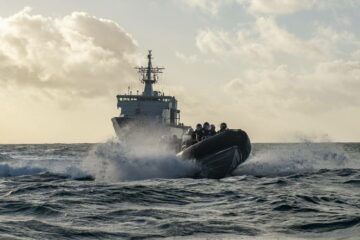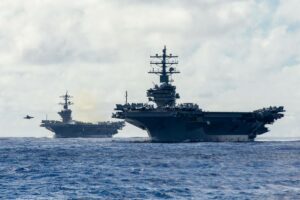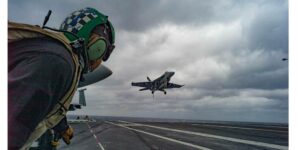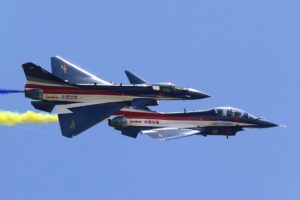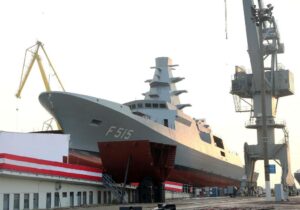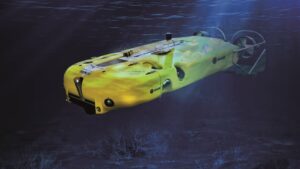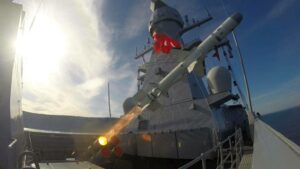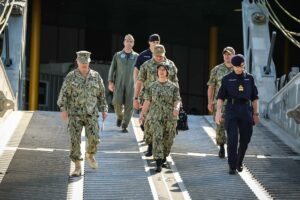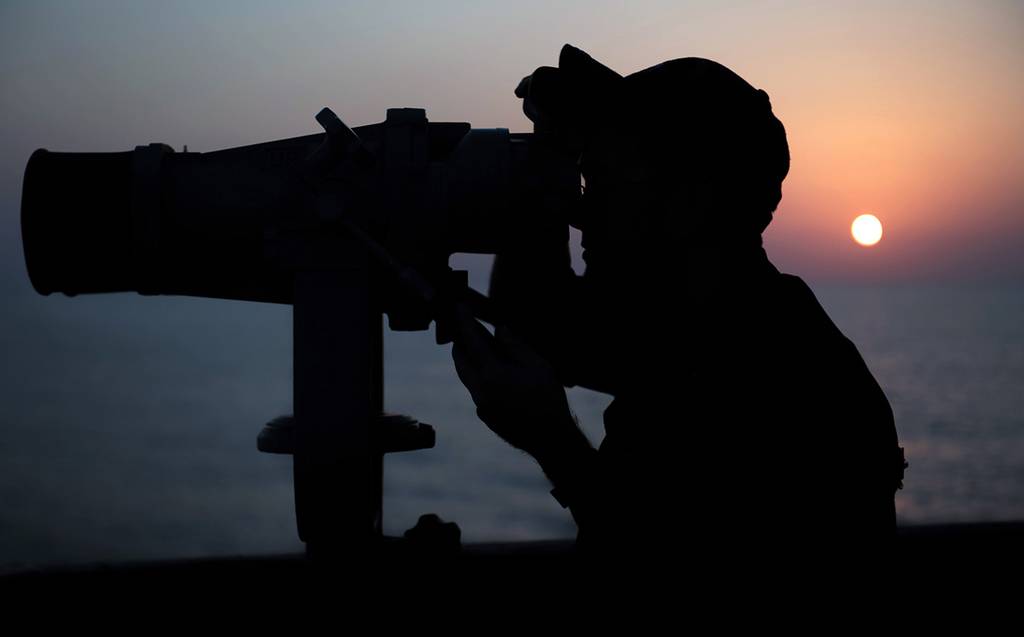
Distributed maritime operations is now the U.S. Navy’s principal concept and doctrine in organizing and fighting. But despite all the rigorous and extensive war gaming and analysis, is DMO viable in an era of precision weapons and nearly ubiquitous surveillance? Or, like the National Defense Strategy’s pursuit of “integrated deterrence” and “campaigning,” is more effort needed in defining and understanding where DMO is effective and where it is not?
DMO aims to increase combat effectiveness by dispersing fleet forces over large areas to deceive and confuse an adversary, and thus reduce detection. In turn, naval units will be hard to locate and thus hard to kill, greatly increasing naval lethality through multidirectional, coordinated attacks. Denial of enemy intelligence, surveillance and reconnaissance capabilities is essential to DMO.
History and theory, however, can provide another way to test DMO. During the late 1950s and early 1960s, Navy aircraft carriers “hid” in the Mediterranean Sea in Operation Haystack to launch retaliatory nuclear strikes against the Soviet Union in the event of war. To justify the 600-ship Navy, then-Secretary John Lehman willingly embraced the Maritime Strategy. Part of that strategy borrowed from “Sea Strike,” a four-carrier battlegroup attack on the Soviet Navy’s Petropavlovsk base in Kamchatka in the northwest Pacific envisioned by then-Command of U.S. Pacific Fleet and future Chief of Naval Operations Adm. Thomas Hayward.
The theory was that the threat of a conventional strike against Soviet naval facilities in Russia would enhance deterrence. Two fatal flaws, however, were dismissed. The first was ignoring that the Soviet Union was prepared to use nuclear weapons. One way of immobilizing any surface force was to detonate an exoatmospheric megaton explosion that created a sufficient electromagnetic pulse to blind the force.
Second, Soviet wartime strategy was not a replay of the World War II-ear U-boat battle of the Atlantic. Instead, the Soviet Navy was designed to protect the ballistic missile submarine bastions in the North Cape and disrupt or destroy the deployed U.S. Polaris force largely with nuclear barrages against their operating boxes at sea. Because of the infamous Walker spy ring operating out of the submarine headquarters in Norfolk, Virginia, the Soviets knew the location of those Polaris operating boxes. Fortunately, no Polaris was ever detected.
About DMO, other questions should be asked: Where do the principles of mass and economy of force apply, and when does dispersal of a force so dilute offensive and defensive capability to render both ineffective? And what about nuclear weapons?
There is no evidence that the Russians have changed their doctrine. Russia has concluded some of its war games and exercises with a nuclear scenario. About China’s People’s Liberation Army, it is not clear what its doctrine would require if war came; but China is increasing its nuclear weaponry.
The U.S. Marine Corps’ Force Design 2030 is based on DMO. However, geography remains an issue. The nearest islands to China from which the Marines would initially operate are Okinawa and Guam. But what is the maximum range of current Marine standoff weapons? Even with Tomahawk, the PLA’s intercontinental ballistic missiles far outrange Marine weapons.
Obviously classification limits public discussion. However, whether attempting to reinforce and resupply Taiwan or launching Sea Strike-like missions against the Chinese mainland, it would seem that China has a dominant cost-exchange advantage.
How then is DMO integrated and coordinated with the National Defense Strategy and regional war plans? Or could DMO become a current equivalent of the 1980s Maritime Strategy — a brilliant marketing plan and probably a complete disaster in a war against the USSR?
The Navy has analyzed and war gamed DMO at every level and in great detail. But has it been sufficiently red teamed? Have all the assumptions been ruthlessly tested? And has this analysis been provided to the fleet and within the bounds of classification to the public?
Further, how is DMO integrated with the joint force and the other services in terms of train, man and equip? A starting point is Force Design 2030. Are Force Design 2030 and DMO closely coordinated operationally and within the shipbuilding plan? And how does DMO relate to the Army’s Project Convergence and the Air Force’s Advanced Battle Management System?
Answers to these questions are insufficient to conclude how relevant and effective DMO is — or may prove to be. However, in their absence, the most prudent course of action is further due diligence on DMO. The typical bureaucratic response will be to follow the status quo and take no additional action. However, that might prove to be a bad idea if the ultimate test comes in battle, and we had not done all the needed homework.
Harlan Ullman is senior adviser at the Washington-based Atlantic Council.
- SEO Powered Content & PR Distribution. Get Amplified Today.
- Platoblockchain. Web3 Metaverse Intelligence. Knowledge Amplified. Access Here.
- Source: https://www.defensenews.com/opinion/commentary/2023/01/23/are-there-flaws-in-the-us-navys-distributed-maritime-operations/
- 70
- a
- About
- Action
- Additional
- advanced
- ADvantage
- against
- aims
- AIR
- aircraft
- All
- analysis
- and
- Another
- Apply
- areas
- Army
- attack
- Attacks
- attempting
- Bad
- base
- based
- Battle
- because
- become
- borrowed
- boxes
- brilliant
- bureaucratic
- capabilities
- carriers
- CGI
- chief
- China
- Chinas
- chinese
- classification
- clear
- closely
- combat
- complete
- concept
- conclude
- concluded
- conventional
- Convergence
- coordinated
- could
- Council
- course
- created
- Current
- Defense
- defensive
- defining
- deployed
- Design
- designed
- Despite
- destroy
- detail
- detected
- Detection
- diligence
- disaster
- discussion
- Disrupt
- distributed
- dominant
- during
- Early
- economy
- Effective
- effectiveness
- effort
- Equivalent
- Era
- essential
- Even
- Event
- EVER
- Every
- evidence
- extensive
- fbi
- fighting
- First
- flaws
- FLEET
- follow
- Force
- Forces
- Fortunately
- from
- further
- future
- Games
- gaming
- geography
- great
- greatly
- Hard
- Headquarters
- homework
- How
- However
- HTTPS
- idea
- images
- in
- Increase
- increasing
- infamous
- initially
- instead
- integrated
- Intelligence
- InterContinental
- Islands
- issue
- IT
- John
- joint
- Kill
- large
- largely
- Late
- launch
- launching
- Lehman
- Level
- limits
- location
- mainland
- man
- management
- management system
- Marine
- Maritime
- Marketing
- Mass
- maximum
- might
- missiles
- missions
- more
- most
- National
- nearly
- needed
- North
- nuclear
- Nuclear weapons
- offensive
- ONE
- operate
- operating
- Operations
- Other
- Pacific
- part
- people’s
- plan
- plans
- plato
- Plato Data Intelligence
- PlatoData
- Point
- Precision
- prepared
- Principal
- principles
- probably
- project
- protect
- Prove
- provide
- provided
- public
- pulse
- Questions
- range
- Red
- reduce
- regional
- reinforce
- relevant
- remains
- require
- response
- rigorous
- Russia
- Russians
- SEA
- senior
- Services
- should
- So
- some
- Starting
- Status
- Strategy
- strike
- Strikes
- sufficient
- Surface
- surveillance
- system
- Taiwan
- Take
- teamed
- terms
- test
- The
- the joint
- the world
- their
- threat
- Through
- to
- Train
- TURN
- typical
- u.s.
- ubiquitous
- ultimate
- understanding
- union
- units
- us
- use
- viable
- virginia
- war
- Weapons
- What
- What is
- whether
- which
- will
- willingly
- within
- world
- would
- zephyrnet

